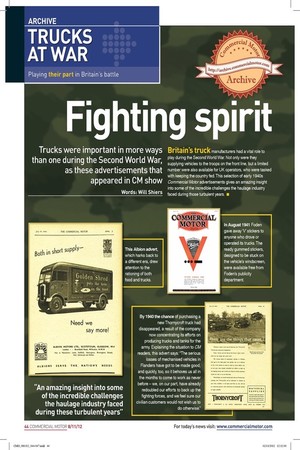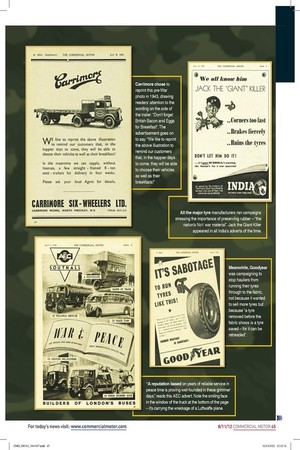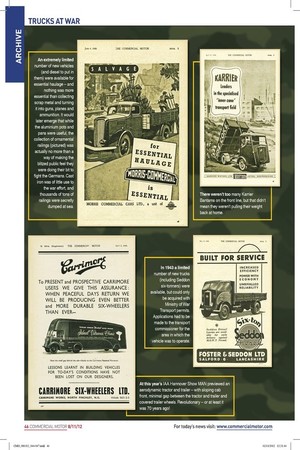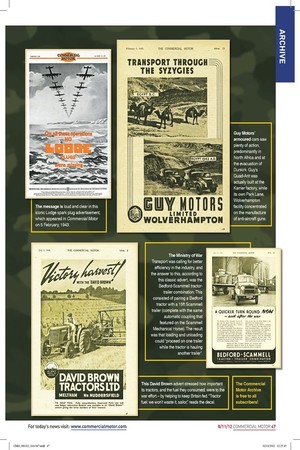Fighting spirit
Page 34

Page 35

Page 36

Page 37

If you've noticed an error in this article please click here to report it so we can fix it.
Trucks were important in more ways than one during the Second WorLd War, as these advertisements that appeared in CM show
Words: Will Shiers
Britain’s truck manufacturers had a vital role to play during the Second World War. Not only were they supplying vehicles to the troops on the front line, but a limited number were also available for UK operators, who were tasked with keeping the country fed. This selection of early 1940s Commercial Motor advertisements gives an amazing insight into some of the incredible challenges the haulage industry faced during those turbulent years. ■ This Albion advert, which harks back to a different era, drew attention to the rationing of both food and trucks.
In August 1941 Foden gave away ‘V’ stickers to anyone who drove or operated its trucks. The ready gummed stickers, designed to be stuck on the vehicle’s windscreen, were available free from Foden’s publicity department.
By 1940 the chance of purchasing a new Thornycroft truck had disappeared, a result of the company now concentrating its efforts on producing trucks and tanks for the army. Explaining the situation to CM readers, this advert says: “The serious losses of mechanised vehicles in Flanders have got to be made good, and quickly, too, so it behoves us all in the months to come to work as never before – we, on our part, have already redoubled our efforts to back up the fighting forces, and we feel sure our civilian customers would not wish us to do otherwise.”
Carrimore chose to reprint this pre-War photo in 1943, drawing readers’ attention to the wording on the side of the trailer: “Don’t forget British Bacon and Eggs for Breakfast”. The advertisement goes on to say: “We like to reprint the above illustration to remind our customers that, in the happier days to come, they will be able to choose their vehicles as well as their breakfasts!” All the major tyre manufacturers ran campaigns stressing the importance of preserving rubber – “the nation’s No1 war material”. Jack the Giant Killer appeared in all India’s adverts of the time.
Meanwhile, Goodyear was campaigning to stop hauliers from running their tyres through to the fabric, not because it wanted to sell more tyres but because “a tyre removed before the fabric shows is a tyre saved – for it can be retreaded”.
“A reputation based on years of reliable service in peace time is proving well-founded in these grimmer days,” reads this AEC advert. Note the smiling face in the window of the truck at the bottom of the page – it’s carrying the wreckage of a Luftwaffe plane. An extremely limited number of new vehicles (and diesel to put in them) were available for essential haulage – and nothing was more essential than collecting scrap metal and turning it into guns, planes and ammunition. It would later emerge that while the aluminium pots and pans were useful, the collection of ornamental railings (pictured) was actually no more than a way of making the blitzed public feel they were doing their bit to fight the Germans. Cast iron was of little use to the war effort, and thousands of tons of railings were secretly dumped at sea. There weren’t too many Karrier Bantams on the front line, but that didn’t mean they weren’t pulling their weight back at home.
In 1943 a limited number of new trucks (including Seddon six-tonners) were available, but could only be acquired with Ministry of War Transport permits. Applications had to be made to the transport commissioner for the area in which the vehicle was to operate.
At this year’s IAA Hannover Show MAN previewed an aerodynamic tractor and trailer – with sloping cab front, minimal gap between the tractor and trailer and covered trailer wheels. Revolutionary – or at least it was 70 years ago! The message is loud and clear in this iconic Lodge spark plug advertisement, which appeared in Commercial Motor on 5 February, 1943. Guy Motors’ armoured cars saw plenty of action, predominantly in North Africa and at the evacuation of Dunkirk. Guy’s Quad-Ant was actually built at the Karrier factory, while its own Park Lane, Wolverhampton facility concentrated on the manufacture of anti-aircraft guns.
The Ministry of War Transport was calling for better efficiency in the industry, and the answer to this, according to this classic advert, was the Bedford-Scammell tractortrailer combination. This consisted of pairing a Bedford tractor with a 15ft Scammell trailer (complete with the same automatic coupling that featured on the Scammell Mechanical Horse). The result was that loading and unloading could “proceed on one trailer while the tractor is hauling another trailer”.
This David Brown advert stressed how important its tractors, and the fuel they consumed, were to the war effort – by helping to keep Britain fed. “Tractor fuel: we won’t waste it, sailor,” reads the decal.









































